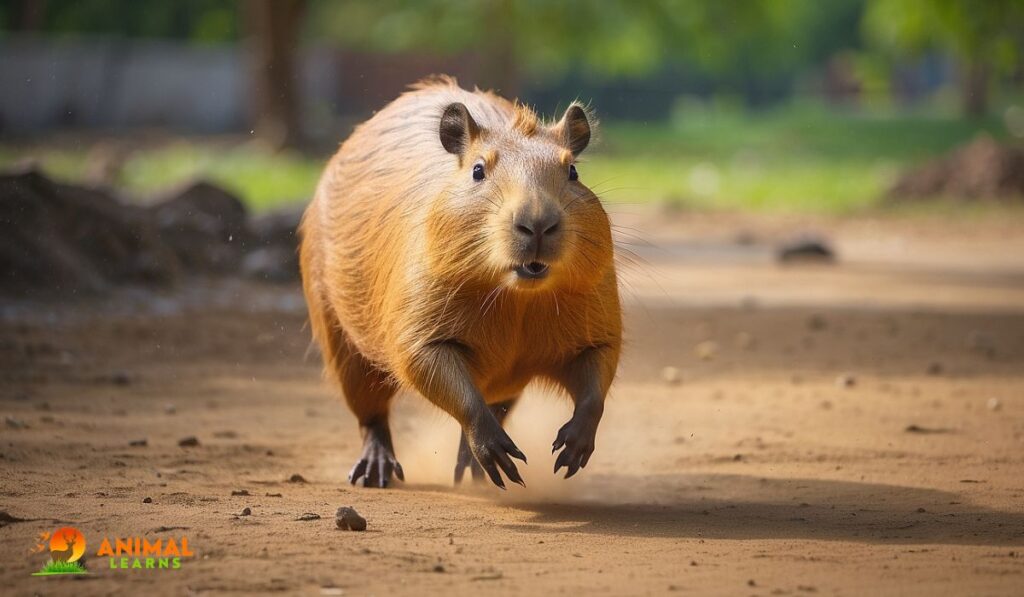How Fast Can A Capybara Run mph? – Animallearns

How Fast Can A Capybara Run? Capybaras are not the quickest animals by nature but they can rapidly escape when they sense danger. What makes capybaras unique is that they are the largest rodents on the planet and capybara running full speed is 16 kilometers (10 miles per hour). Capybaras are also known to be giants by size which only makes them big prey to the predators.
They have amazingly long legs that help them to run very fast and make narrow turns as well as quick sudden halts. Their sharp and robust claws support a firm grip and enable them to climb very well. Capybaras are very swift animals, hence their speed and ability to maneuver make them the best running buddies.
What is a Capybara?
Contents
Capybara is the name given to the rodent native to South America. They are the largest living rat species in the world, growing up to an average weight of 30 kg to 70 kg. Capybaras are herbivores that mainly eat grass, aquatic plants, leaves, and fruits, unlike turtles and tortoises which are omnivores or insectivores.
They are good swimmers because of their webbed toes which help them to swim through water. Yet, they are semi-aquatic and very sociable, for they sometimes live in herds containing up to 40 individuals.
Additionally, they can climb well and their sharp claws come in handy as they hold onto branches. Capybaras also come out at night and sleep during the day; they hide in burrows or dens while they are sleeping. They are very adaptable and capable of excelling in different landscapes, such as forests or marshes.
Capybaras have body shapes like the barrel, heads short, reddish-brown upper parts, and yellowish-brown lower parts. They have small webbed feet, small ears, and barely hardtails.
How Fast Can a Capybara Run on Land?

Capybaras are the largest rodents on Earth they do not have the speed of the fastest land animal. Capybaras have a good sprint speed that can make them very slippery to capture. They can move at the rate of 10mph, which is faster than humans.
In case you are hunting capybaras, it is vital to have a strategy in order with your speed just insufficient to pursue them.
They can sense them and run away from them if they sense danger. They can take evasive action rapidly in the form of sudden turns and twists. They are amazingly fast runners which makes it almost impossible for predators such as leopards, ocelots, and jaguars, to catch up with them.
Why Do Capybaras Run?
Capybaras may be calm and quiet, but they can also be easily chased. Almost always, you can guess a capybara is running for the sake of finding some food or escape from something. Curious capybaras are quick to sniff out opportunities in their favor. They roam across large areas of land to search for food.
The sooner they appropriate food sources, the higher their chances of survival. The reason is that capybaras have great amounts of food needed and it is hard for them to control their hunger. Finding the right type of food on time will save a lot of their energy.
How Fast Can A Capybara Swim?

Capybaras might seem like big guinea pigs hanging out near water, but they’re pretty fast swimmers! They can zip through the water at about 5 miles per hour (8 kilometers per hour), which might not be as fast as dolphins or sharks, but it’s impressive for an animal their size.
They have webbed feet, special eyes, and noses, and they can hold their breath for up to 5 minutes, all of which help them swim well. Swimming also helps capybaras stay safe from predators like jaguars and caimans and keeps them cool on hot days. So, when you see a capybara chilling by the water, remember—they’re not just relaxing, they’re also amazing swimmers in the animal world!
Evade Dangerous Predators
There are some predators (jaguar, ocelot, caiman, boa constrictor, and puma) that hunt capybaras for food. The capyba is prey for the larger snakes like anacondas and other animals like caimans, ocelots, pumas, and jaguars just like the small prey like insects, rodents, and birds.
On seeing the predator, the leader of the capybara calls on doing so and the entire herd runs for safety. Similarly, the capybara can have other ways of protecting itself by the use of other mechanisms if it is under threat or attack. Its sharp teeth can bite into or sink their teeth into your flesh or the flesh of any potential attacker.
The predators’ first reaction to their existence is to run away. Capybara are too swift and they can cross 10mph. This feature in their running helps them escape their predators and look for a place of safety.
Food
Capybara, the grazing animals, must forage every day. For them to be successful in their search, their supernatural ability to move very fast plays a huge part.
In their search for a perfect eating spot, these animals would be fleeing from area to area in a bid to find the best grass of all time. Knowing that their best-performing trait of 10mph is useful in getting them to potential food sources will make hunting easier.
How Do Capybaras Run?

Capybaras have strong, short legs that keep them steady and strong, which is important because they have big bodies and can move quickly.
Their feet are partly webbed, which helps them swim and run, especially in muddy areas near water. Capybaras have a body shape that’s low to the ground, which makes them stable when they run and helps them turn quickly.
When capybaras run fast, they usually use a type of run called galloping. In this run, all four of their feet leave the ground, which helps them go faster because they get short times where they’re in the air.
How Fast and Agile Capybaras Are?
Even though they are big, capybaras can run as fast as 35 kilometers per hour (that’s about 22 miles per hour)! They can also move quickly and change direction suddenly. This is important for them to get away from animals that want to eat them.
How Long Capybaras Can Keep Running?
Capybaras can keep running at their fast speed for a few minutes. This helps them a lot when they need to run away from animals that are chasing them.
Capybara Anatomy

Structure and Physiology
Capybaras have a special structure, which turns on the possibility of their performing quick body movements or running fast. These giant rodents possess short legs that are covered with thick furs which helps them run fast.
Their broad and robust chest and hindquarters are lusty components that they benefit from because they aid them to push forward.
Their long and flat tails do two things – the main one being that it offers them balance and the second one is that it acts as a paddle or rudder used in cases where they run or swim. The tail helps them in making quick turns and twists during such cases as they try to evade predators or look for food.
They are equipped with a flexible spine grazing as a shock absorber while running and allowing the animal to slow down when needed. Injury prevention while running is a benefit of this and also gives the body more energy for other activities.
Moreover, capybaras have a distinct nasal system that is not similar to other beings of this type. Capybmas and the long air sacs in their noses ensure fresh air is drawn into the lungs.
They have good eyes and ears which could alert them to impending dangers and aid them escape easily. They possess eyes that are quite large and thus can see danger from a distance.
Capybaras possess strong hind legs which are great for moving faster on land and in the water. The paws of these animals are webbed; thus, they can swim well.
Almost immediately, capybaras run after seeing a predator, and their heart rates go up. They take advantage of burrows to hide and shelter, and sometimes to store food. Their natural fur covering provides them insulation, which keeps them warm and makes their body temperature stable even in winter.
Analysis of Capybara Speed
When considering the question ‘How Fast Can A Capybara Run,’ it’s fascinating to note that capybaras are capable of running speedily up to 10 mph if they perceive themselves in danger. Additionally, they can maintain a steady jogging rhythm of 5 mph across any terrain, be it flat or uneven.
The lean appearance of their muscular limbs, being great for their speed, and their large strong feet suggest that they are very agile. The main reason for their long leg stride and fast speed is their body structure.
Their speed like their diet can be attributed to them as well. By eating all the vegetation they can get, they can guarantee they will be full of strength and stamina making them even faster. The ability them be semi-aquatic and also swim at a fast speed makes them even more convenient in escaping the predators.
Top Speed
These rodents can reach very fast speeds. They can reach a length of 10 miles when they get threatened. This necessary additional speed can be maintained for up to 3 minutes and it multiplies their chances of escaping predators.
It’s very impressive what they can do, considering how big they are.
To attain this, capybaras have certain traits that are geared to let them run faster. The lengths of their legs are greater compared to other rodents but their feet are webbed, which increases the surface area that they can hold on to and more grip when running. The large body mass assists them in both developing momentum and sustaining the speed as they run.
Average Speed
Can run up to 6 miles per hour on average for short distances. Considering their enormous size, even while that might not seem like much, it can nevertheless be very amazing. They also have a somewhat different form of movement than most other creatures, which makes it difficult for them to sustain such a high pace for an extended amount of time.
Comparison of Capybara Running Speed with Other Rodents

Capybaras are special rodents, not only because they’re big but also because they can move quite fast. Let’s see how they compare to some other rodents:
| Animal | Average Speed | Characteristics |
| Brown Rat | 8 kph (5 mph) | Brown rats move quickly but not as fast as capybaras. |
| Squirrel | 20 kph (12 mph) | Squirrels can move fast in trees and on the ground, helping them run away from predators. |
| Guinea Pig | 9 kph (5.5 mph) | Guinea pigs can run a little bit fast for short distances, but they’re slower than capybaras. |
| Beaver | 6 kph (3.7 mph) | Beavers are better at swimming than running on land, so they’re slower than capybaras when they’re out of the water. |
| Chipmunk | 21 kph (13 mph) | Chipmunks are tiny but can run very fast for their size, making quick movements to escape from danger. |
| Hamster | 6 kph (3.7 mph) | Hamsters are good at moving quickly, especially in their tunnels, but they’re slower than capybaras overall. |
As we’ve explored the question ‘How Fast Can A Capybara Run,’ it’s fascinating to note that these charismatic creatures are not only renowned for their gentle demeanor but also their remarkable speed.
Conclusion
Animal enthusiasts must be aware that capybaras are incredibly fast animals. Giving your pet capybara a safe, secure area that restricts their freedom of movement is a smart idea. You should take measures to prevent capybaras from accessing your garden and harming your plants if you reside in an area where they are widespread.
Because of their intelligence, capybaras can discern when to flee for safety. Because they are timid animals, capybaras may run from unknown people. They benefit from their ability to run because it allows them to avoid predators, locate food, and form group relationships.
FAQs
How fast can capybaras run?
Estimates vary, but capybaras can reach speeds of 22-35 kilometers per hour (14-22 mph). That’s roughly as fast as a domestic dog or even a trotting horse!
Are capybaras fast for their size?
Absolutely! Despite their large bodies, capybaras are surprisingly agile and swift. This helps them escape predators like jaguars and caimans.
Do capybaras run often?
While not marathon runners, capybaras can be surprisingly active. They use bursts of speed for short distances when threatened or playing.
Why do capybaras need to run fast?
It’s all about survival! Being able to outrun predators is crucial for these social animals, especially when protecting young or vulnerable members of their group.
Can I outrun a capybara?
Probably not! Unless you’re an Olympic sprinter, a capybara’s burst of speed would likely leave you in the dust. Better admire their agility from a safe distance.












